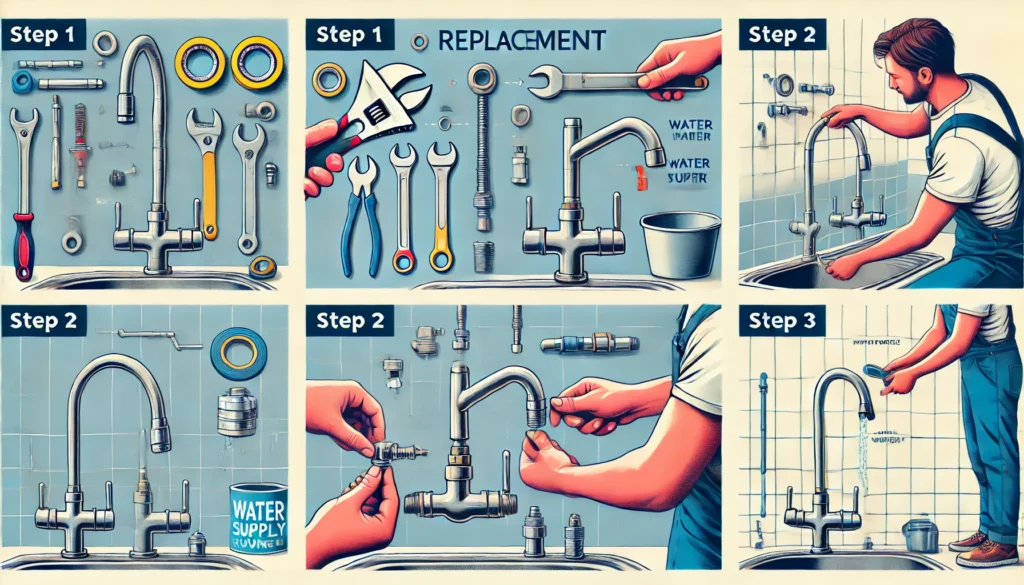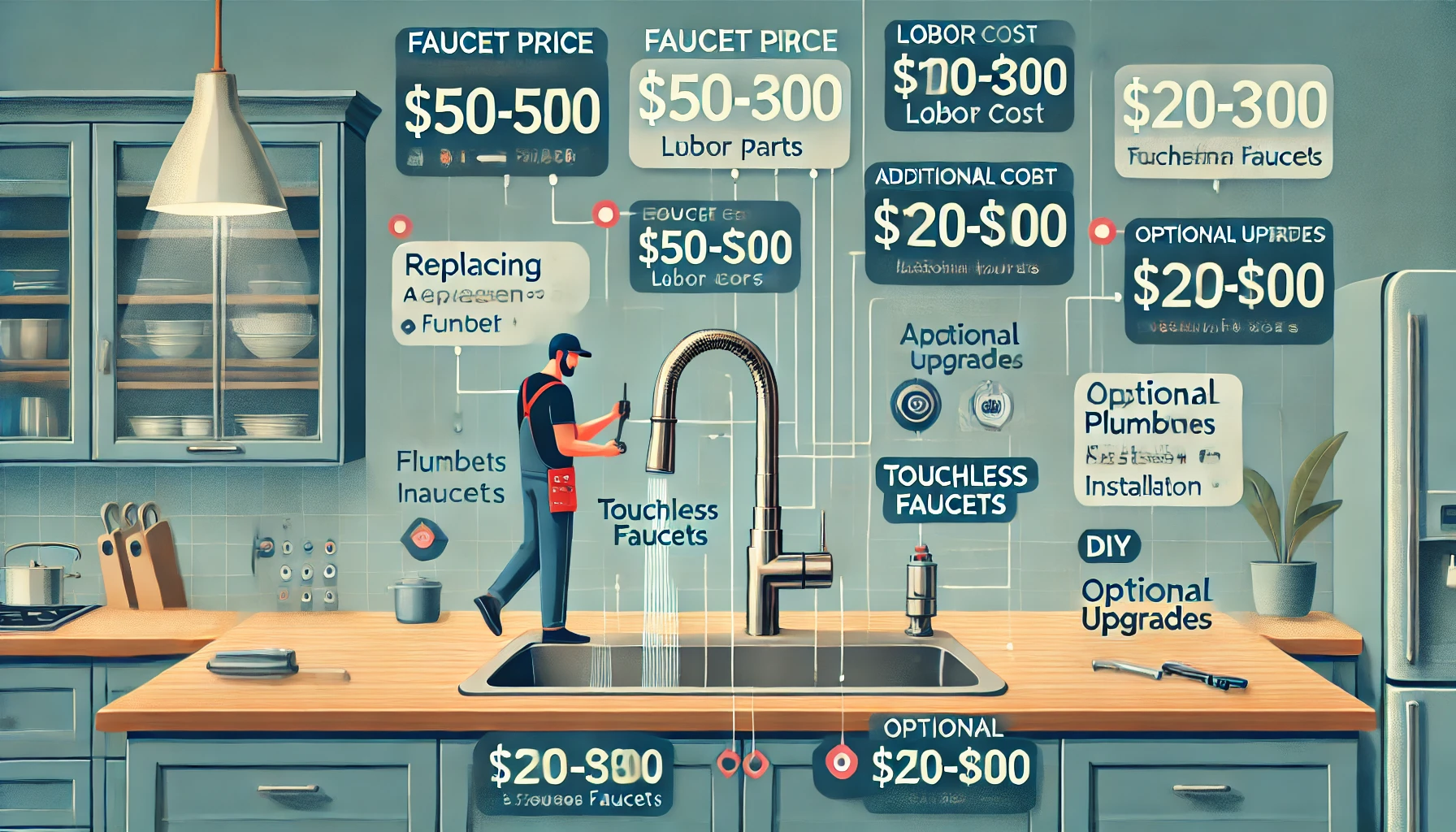Introduction
Replacing a kitchen faucet might seem like a minor upgrade, but it can make a big difference in your kitchen’s functionality and aesthetics. Whether your old faucet is leaking, outdated, or simply not working efficiently, installing a new one can improve water flow, reduce waste, and enhance your kitchen’s overall look.
Before diving into the costs and steps involved, it’s important to understand that the price of replacing a kitchen faucet varies based on several factors, including the type of faucet, labor charges, and additional plumbing needs.
This guide will walk you through every aspect of replacing a kitchen faucet, from cost considerations to a step-by-step installation process.
Why Replacing a Kitchen Faucet Matters
A kitchen faucet is one of the most frequently used fixtures in any home. Over time, wear and tear can lead to issues like leaks, reduced water pressure, or rust buildup. Replacing your faucet can help in several ways:
- Prevents Water Damage – A leaking faucet can cause mold and water damage under the sink.
- Improves Water Efficiency – Modern faucets are designed to conserve water, reducing your bills.
- Enhances Kitchen Aesthetics – A new faucet can instantly refresh the look of your kitchen.
- Adds Convenience – Features like pull-down sprayers, touchless activation, and smart controls make kitchen tasks easier.
Factors That Influence Replacement Costs
The cost of replacing a kitchen faucet is not fixed. Several factors affect the overall price, including:
- Type of Faucet – Basic models cost less than high-tech, smart faucets.
- Installation Complexity – If your plumbing needs modifications, costs increase.
- Professional vs. DIY Installation – Hiring a plumber adds labor costs but ensures proper installation.
- Additional Parts – Shut-off valves, supply lines, and other plumbing parts may need replacing.
Now, let’s dive into the detailed cost breakdown of replacing a kitchen faucet.
Read More: how to paint kitchen cabinets without sanding
Understanding the Costs of Kitchen Faucet Replacement
Replacing a kitchen faucet involves more than just the cost of the faucet itself. The overall expense includes labor charges, additional plumbing materials, and the complexity of the installation. Whether you choose to install it yourself or hire a professional, understanding the various costs involved will help you budget effectively.
On average, replacing a kitchen faucet costs between $150 and $400, but this price can go higher depending on the faucet type and labor costs. Below is a detailed breakdown of the expenses involved.
Average Cost to Replace a Kitchen Faucet
The cost of replacing a kitchen faucet varies depending on several factors, such as the brand, type of faucet, and installation complexity. Here’s a general pricing range:
- Basic Faucet Replacement (DIY) – $50 to $150
- Mid-Range Faucet (Professional Installation) – $150 to $400
- High-End or Smart Faucets (With Professional Installation) – $400 to $1,000+
If you choose to install it yourself, you’ll only need to pay for the faucet and any necessary tools. However, if you hire a plumber, the labor costs will add to the total expense.
Breakdown of Expenses
Let’s break down the key expenses associated with faucet replacement:
Cost of the Faucet Itself
The price of a new kitchen faucet largely depends on the type, brand, and features. Here’s what you can expect:
- Basic Faucets – $50 to $150
- Mid-Range Faucets (Pull-Down or Pull-Out Sprayers) – $150 to $300
- High-End Faucets (Touchless, Smart Features) – $300 to $800+
Luxury brands and high-tech models with motion sensors, temperature control, and filtered water dispensers can cost even more.
Labor Costs (DIY vs. Professional Installation)
If you hire a plumber, labor costs can range between $100 and $300, depending on the complexity of the installation. Here’s what affects the price:
- Removing an old faucet and installing a new one is relatively simple and costs less.
- If plumbing modifications are needed, such as replacing shut-off valves, costs increase.
- Hiring a professional ensures proper installation, reducing the risk of leaks and future repairs.
Additional Plumbing Parts and Tools
Even if you already have the faucet, you might need extra materials for installation. Common additional costs include:
- New Supply Lines – $10 to $30
- Plumber’s Putty & Sealants – $5 to $15
- Shut-Off Valves – $20 to $40 (if replacements are needed)
- Tools (If DIY Installation) – $20 to $50 (for adjustable wrenches, plumber’s tape, etc.)
Cost Variations Based on Faucet Type
Not all kitchen faucets cost the same. The price largely depends on the design, features, and brand. Below, we’ll explore the different types of faucets and their cost variations.
Single-Handle vs. Double-Handle Faucets
One of the key factors affecting the cost is whether you choose a single-handle or double-handle faucet.
- Single-Handle Faucets ($50 – $300)
- These faucets have one lever to control both water temperature and flow.
- They are easier to install and usually more affordable.
- Ideal for small sinks and modern kitchens.
- Double-Handle Faucets ($100 – $400)
- These faucets have separate handles for hot and cold water.
- They offer better temperature control but require more space and a slightly more complex installation.
Pull-Down vs. Pull-Out Faucets
Both pull-down and pull-out faucets have detachable spray heads, but they serve slightly different purposes.
- Pull-Down Faucets ($150 – $500)
- The spray head pulls down into the sink, offering better control for washing dishes.
- Ideal for deep sinks.
- Usually costs more due to added functionality.
- Pull-Out Faucets ($100 – $400)
- The spray head pulls outward, making it more flexible for filling pots.
- Better suited for smaller sinks.
- Slightly less expensive than pull-down models.
Touchless and Smart Faucets
Technology has transformed kitchen faucets, adding convenience but also increasing the cost.
- Touchless Faucets ($250 – $800)
- Operate with motion sensors to reduce water waste.
- Great for maintaining hygiene but require batteries or electrical power.
- Smart Faucets ($500 – $1,500+)
- Can be controlled via voice commands or smartphone apps.
- Offer features like preset water temperatures and volume control.
- Most expensive option but ideal for high-tech kitchens.
Read More: how to paint kitchen cabinets professionally
Step-by-Step Guide to Replacing a Kitchen Faucet

Now that you understand the costs, let’s walk through the actual replacement process. This step-by-step guide will help whether you’re doing it yourself or hiring a professional.
Step 1: Preparing for the Replacement
Before starting, gather all necessary tools and prepare your workspace.
Tools and Materials Needed
To replace a kitchen faucet, you will need:
- Adjustable wrench
- Basin wrench
- Plumber’s tape
- Bucket or towel (to catch water)
- New supply lines (if needed)
- Plumber’s putty or silicone sealant
Shutting Off the Water Supply
- Locate the shut-off valves under the sink.
- Turn them clockwise to stop the water flow.
- Open the faucet to release any remaining water pressure.
Assessing the Sink and Plumbing Compatibility
- Check the number of holes in your sink (single-hole or three-hole).
- Ensure your new faucet matches your sink’s configuration.
- If needed, purchase an escutcheon plate to cover extra holes.
Step 2: Removing the Old Faucet
Once the preparation is done, it’s time to remove the old faucet.
Disconnecting Water Supply Lines
- Use an adjustable wrench to loosen and disconnect the supply lines from the shut-off valves.
- Place a bucket under the sink to catch any water drips.
Loosening and Removing Mounting Nuts
- Use a basin wrench to loosen the nuts securing the old faucet.
- Carefully lift the old faucet from the sink.
Cleaning the Sink Area Before Installation
- Remove any old sealant or plumber’s putty.
- Wipe the sink surface clean to ensure a proper seal for the new faucet.
Step 3: Installing the New Faucet
Now that the old faucet is removed, you can install the new one.
Positioning and Securing the Faucet
- Insert the new faucet into the sink holes.
- Secure it with mounting nuts from underneath the sink.
- Tighten the nuts with a wrench to hold the faucet firmly in place.
Connecting Water Supply Lines
- Attach the hot and cold water supply lines to the corresponding valves.
- Tighten them securely, but avoid overtightening.
Checking for Leaks and Adjusting Water Flow
- Turn on the water supply valves.
- Open the faucet and let water run to check for leaks.
- If leaks appear, tighten the connections or apply plumber’s tape.
DIY vs. Hiring a Professional: Which Is Better?
Deciding whether to install a kitchen faucet yourself or hire a plumber depends on your skill level and budget.
Pros and Cons of DIY Faucet Replacement
- Pros:
- Saves money on labor costs.
- Can be done in a couple of hours with basic tools.
- Cons:
- Risk of improper installation leading to leaks.
- Can be challenging if plumbing modifications are needed.
When to Call a Professional Plumber
- If you have old, corroded pipes that may break during installation.
- If shut-off valves are not functioning properly.
- If you’re unsure about the installation process.
How to Find a Reliable Plumber and Estimated Costs
- Ask for recommendations or check online reviews.
- Compare multiple quotes to find a fair price.
- Expect to pay between $100 and $300 for installation.
Additional Costs to Consider
Replacing a faucet may involve extra costs beyond just the fixture and installation.
Replacing Shut-Off Valves
- If the shut-off valves are old or leaking, replacing them costs $20 to $50 per valve.
Upgrading Supply Lines
- New supply lines may cost $10 to $30 but help prevent future leaks.
Costs of Unexpected Repairs
- If plumbing repairs are needed, costs can rise significantly, adding $50 to $200 extra.
How to Save Money on Kitchen Faucet Replacement
Want to replace your faucet without overspending? Here are some tips.
Choosing a Budget-Friendly Faucet
- Stick to reputable brands with good warranties.
- Avoid unnecessary features if you’re on a budget.
Looking for Discounts and Deals
- Shop during sales events like Black Friday.
- Consider open-box or clearance items.
Avoiding Common Mistakes That Lead to Extra Costs
- Measure sink holes before buying a new faucet.
- Don’t overtighten connections, which can cause leaks.
Conclusion About How Much to Replace a Kitchen Faucet
Replacing a kitchen faucet is a simple yet impactful upgrade for your home.
Final Thoughts on Kitchen Faucet Replacement Costs
- Expect to spend $150 to $400 for a standard replacement.
- Costs vary based on faucet type, labor, and additional plumbing needs.
Is It Worth DIY or Hiring a Pro?
- DIY can save money but requires basic plumbing knowledge.
- Hiring a plumber ensures proper installation and avoids future issues.
With the right knowledge, you can make an informed decision and successfully replace your kitchen faucet within your budget.

